
Sleep Apnea – What to Know If You Were Exposed to Burn Pits
Recently, the passage of the PACT Act opened the door to veterans who had been harmed by burn pit exposure to pursue VA disability benefits. The PACT Act significantly expanded the VA’s list of conditions presumptively connected to burn pit exposure. Sleep apnea is not on that list.
However, that doesn’t necessarily mean that you can’t pursue a claim for veterans disability benefits. Many disabled veterans establish disability ratings and receive VA disability benefits by providing evidence of a service connection. If you were exposed to burn pits during your military service and now suffer from sleep apnea, here’s what you need to know.
Burn Pits and Sleep Apnea
Military burn pits were used to dispose of a wide range of materials, from human waste to chemicals to unexploded ordnance. Many of these materials released toxins into the air, and those toxins affected exposed service members in many different ways. Some were simple and temporary, such as skin irritations. Others were more serious, including several different types of cancer.
However, much remains unknown about the effects of exposure to a wide range of biological and chemical contaminants in the air around burn pits. The health impacts of burn pit exposure are still under investigation, and it’s possible that a direct connection between burn pit exposure and sleep apnea will be discovered. We know that Gulf War veterans develop sleep apnea at higher than usual rates, but the reason has not yet been identified. And, these veterans can pursue VA disability benefits for sleep apnea–they simply have to provide sufficient medical evidence to establish the connection.
Sleep Apnea as a Secondary Service-Connected Condition
Veterans who already have a VA disability rating for another burn pit related condition may also be able to establish a secondary service connection for sleep apnea. Some evidence indicates that sleep apnea is linked to other conditions that have a presumptive connection to burn pit exposure. For example:
- Sleep apnea has been found to be more common in patients with chronic bronchitis
- Studies have shown a link between asthma and sleep apnea
- Chronic obstructive pulmonary disease (COPD) can contribute to obstructive sleep apnea
If you were exposed to burn pits during your military service and developed sleep apnea, you may be able to establish a service connection or secondary service connection. But, there’s no presumption, which means you will likely have to present significant medical evidence to establish the connection.
To learn how a seasoned veterans disability benefits advocate may be able to help you establish your claim, contact us here or call (855) 855-8992 right now.

How to Speed Up Your VA Disability Claim
How to Speed Up Your VA Disability Claim The VA says that in January of 2024, the average time for...

How to Apply for VA Disability Compensation
It's one thing to know how to apply for VA disability compensation. It's another to understand the...

What is the VA DBQ?
What is the VA DBQ? A VA Disability Benefits Questionnaire (DBQ) is a form used to convey...





